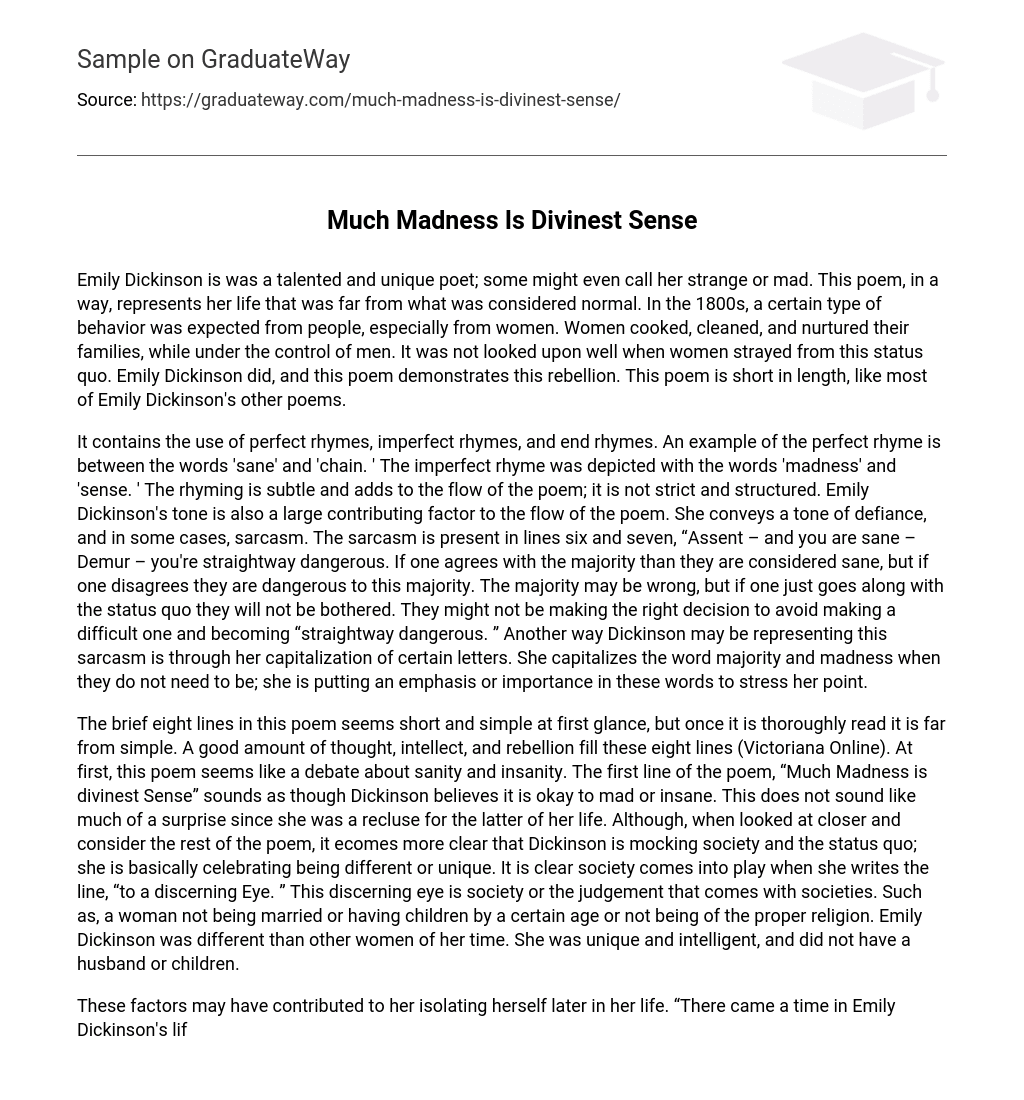Emily Dickinson, an exceptional and singular poet, could be characterized as peculiar or deranged. This poem mirrors her atypical existence that diverged from established conventions. During the 1800s, there were distinct societal demands placed on individuals, especially women. Women were anticipated to fulfill domestic duties such as cooking, cleaning, and tending to their families—all under male authority. Challenging this prevailing norm was disapproved of. Nevertheless, Emily Dickinson resisted these anticipations evident in this poem. Like numerous of her other compositions, this poem is likewise concise.
The poem utilizes perfect, imperfect, and end rhymes. For instance, a perfect rhyme is found between ‘sane’ and ‘chain.’ The use of imperfect rhyme is exemplified by ‘madness’ and ‘sense.’ The rhyming in the poem is subtle and enhances the rhythm, without strictly adhering to a structured form. Emily Dickinson’s tone also greatly contributes to the flow of the poem. She conveys a tone of defiance and occasional sarcasm. The sarcasm is evident in lines six and seven: “Assent – and you are sane – Demur – you’re straightway dangerous.” According to the majority, agreeing makes one sane, but disagreeing makes one dangerous. Although the majority may be mistaken, going along with the status quo will avoid trouble. By conforming, they may not be making the correct decision, but it shields them from becoming “straightway dangerous.” Capitalizing certain letters further emphasizes Dickinson’s point. She capitalizes words like majority and madness unnecessarily, emphasizing their significance.
The poem may seem short and simple, but it reveals a depth that goes beyond simplicity. It is filled with thought, intellect, and rebellion. Dickinson believes it is acceptable to be mad or insane, mocking society and the status quo. She celebrates being different or unique, while acknowledging societal judgment and expectations. Emily Dickinson herself was unlike other women of her time – unique, intelligent, and chose not to marry or have children.
These factors may have contributed to Emily Dickinson isolating herself later in her life. According to Dickinson (19), there came a time in her life when she chose to never leave her home again. As a recluse, she wrote over 1800 poems until the day she died. Although she was not considered insane and was known for her intelligence, society’s discerning eye and judgement may have driven her to this seemingly insane behavior. After isolating herself, Dickinson’s writings and poetry reflected her loneliness. Her poems often depict speakers living in a state of want, but they also contain moments of inspiration that suggest the possibility of happiness (Poets Online). The last line of the poem emphasizes the theme of rebellion, as the capitalized word “chain” evokes thoughts of slaves and lack of free will.
According to Victoriana Online, women in the 1800s had limited free will and were not equivalent to slaves. Emily Dickinson’s poem focuses on escaping the control of marriage or even an insane asylum. She is seen as a significant poet of the nineteenth century, despite her poems not being published under her name until after her death.
Despite writing some anonymously and sharing poems with friends, Emily Dickinson’s writing went beyond that. After her death, her family discovered 40 handbound volumes containing nearly 1800 of her poems, also known as “fascicles” (Poets Online). It is evident that Dickinson wrote these poems for herself, not seeking wealth or fame, but rather to express her thoughts and emotions that were unable to be conveyed during her time. “Much Madness is divinest Sense” exemplifies Dickinson’s intellect, creativity, and defiance, as she refused to conform to societal norms and instead created her own path.
Works Cited
“Emily Dickinson.” Poets.org: From the Academy of American Poets. Copyright 1997-2012. Retrieved November 21, 2012. http://www.poets.org/poet.php/prmPID/155 Dickinson, Emily, Thomas Herbert Johnson, and Theodora Ward. The Letters of Emily Dickinson. Belknap Press, 1986. 19.





